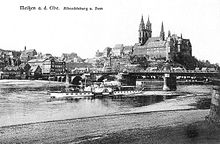Königstein (ship, 1915)
|
Paddle steamer Field Marshal von Hindenburg on the Elbe
|
||||||||||||||||||||
|
||||||||||||||||||||
|
||||||||||||||||||||
|
||||||||||||||||||||
|
||||||||||||||||||||
The paddle steamer Königstein is the last ship to be built in the Laubegast shipyard during the First World War and the subsequent economic crisis . The ship was under the name of Field Marshal von Hindenburg with the hull number 56 in 1915 to set keel . In 1919 it was named Königstein as the second ship .
The time after commissioning until 1945
Due to the repeatedly low water level of the Elbe in summer, the company decided to build a smooth deck steamer with a shallow draft. It was named after Paul von Hindenburg , Field Marshal General of the German Army at the time . After commissioning, the ship drove for the Saxon-Bohemian Steamship Company (SBDG). After the cessation of business operations in 1923, the ship sailed for the Saxon-Bohemian Steamship Company (SBDA), which was newly founded in 1923 . The white painting of the ships, which was customary from 1926, earned it the name White Fleet . It had a steam steering engine and a wheelhouse. The steam control machine was built by the Dresdner Maschinenfabrik und Schiffswerft Uebigau AG with factory no. 1454. In size, the ship is comparable to the Pillnitz . According to today's standards, the number of passengers is likely to be around 400. In October 1919, like all ships bearing the name of a monarch or a monarchy, it was renamed and given the name Königstein .
On March 4, 1926, the ship wrecked while transporting two jetties at Marienbrücke . The right wheel arch was destroyed.
In the winter of 1927/28 the ship was rebuilt. The hull was lengthened by 3.66 m and the wheel arches were removed to make room for the installation of toilets. In addition to the construction of an upper deck, a deck saloon and steam heating were installed in the stern. At the same time the ship was painted white.
On July 19, 1929, the Königstein collided in Bodenbach with a barge belonging to the NDBG (New German-Bohemian Elbeschiffahrt Aktiengesellschaft). A wheel arch was damaged in the process.
In the summer of 1943, like all steamers , the Königstein was camouflaged. From July 29th to August 4th 1943 the ship was used for evacuation measures after the bombing raids in Hamburg . Nothing is known about their further use in World War II .
The time after 1945
In 1946 it was incorporated into the newly founded Soviet State Oderschiffahrts-AG (SOAG) and on July 3, 1946, it was confiscated as a reparation payment and transferred to the Soviet Union . In the shipyard in Roßlau , the superstructures and wheel arches were removed in order to be able to pass the low bridges and narrow locks on the way to Stettin . After crossing the Baltic Sea , the ship was used as a transport ship in the Leningrad area. Nothing is known about the further whereabouts.
The steam engine
The steam engine was an inclined, high-pressure two-cylinder composite steam engine with injection condensation. Like the two-flame tube cylinder boiler, it was built by Dresdner Maschinenfabrik und Schiffswerft Uebigau AG, with factory no. 1453. The power was 180 hp. The steam boiler had a steam pressure of 11 bar . The steam engine was a high-speed machine with 60 instead of the usual 40 revolutions / min. Therefore, the paddle wheels were smaller than before. However, the machine did not prove itself.
Captain of the ship
- Arno Julius Junghans 1916–1920
See also
List of ships with the name Königstein
literature
- Erlpeter Kulturblatt for Pirna, issue 34 / April 2004
- Shipping calendar for the Elbe area and the Märkische Wasserstrassen from 1915 to 1920


